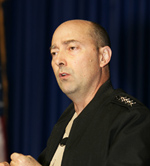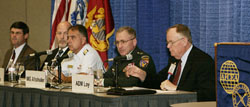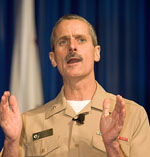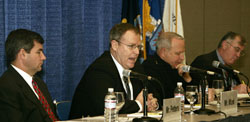Quote of the Day: “Drugs are the fuel in the car of misery in this part of the world.”—Adm. James G. Stavridis, USN, commander, U.S. Southern Command
WEST 2008 Online Show Daily
Day 2
By Robert K. Ackerman
 |
| Adm. James G. Stavridis, USN, commander of the U.S. Southern Command, introduces the Wednesday luncheon audience at West 2008 to the serious challenges in his area of operation. |
While public attention has been focused on
That was the message delivered by both a speaker and a panel on the second day of West 2008, the annual conference and exposition sponsored by AFCEA International and the U.S. Naval Institute. Adm. James G. Stavridis, USN, commander of the U.S. Southern Command (SOUTHCOM), told a luncheon audience that the counterdrug struggle is an increasingly important facet of national security.
The admiral stunned his audience with statistics on the cost of illegal drug use in the
 |
| A panel on the war on drugs discusses successes and challenges in that long-term endeavor. Panelists are (r to l) moderator Adm. James Loy, USCG (Ret.), former deputy secretary of homeland security; Maj. Gen. Herbert A. Altshuler, USA, director, strategy, plans and programs, U.S. Africa Command; Rear Adm. Joseph Nimmich, USCG, director, Interagency Task Force South; Special Agent Michael A. Braun, assistant administrator, chief of operations, Drug Enforcement Administration; and Bob Knotts, deputy chief, J3 Joint Operations Division, U.S. Southern Command. |
And the drug traffickers are becoming more sophisticated and innovative. They have been employing semi-submersible watercraft that can carry up to 5 tons of cocaine. These vessels and their two-man crews can sprint at speeds of up to 15 knots. Several have been caught in the past year, he noted, and the traffickers continue to improve them.
To help in its drug interdiction efforts, SOUTHCOM will need full-spectrum awareness, particularly maritime domain awareness; distributed, networked wireless sensors; long-dwell unmanned sensors; and an improved version of relocatable over-the-horizon radar. It also may be able to use an effective version of airborne laser mine detection technology to pick up semi-submersibles, as well as surface-towed torpedo technology to find fast boats used by smugglers.
And, SOUTHCOM is “very into rivers,” Adm. Stavridis offered. The m-hull Stiletto, built by the Office of Force Transformation (SIGNAL Magazine, March 2006), will be employed to help conduct counternarcotic operations.
 |
| Rear Adm. Michael P. Tillotson, USN, commander, Navy Expeditionary Combat Command (NECC), describes the scope of his command’s mission to a West 2008 breakfast audience. |
Roughly 90 percent of the world’s commerce travels through sea lanes, he observed. Many of these are coastal waterways; and to cover them all, the Navy must engage and partner with others, the admiral stated.
Many enemy naval forces look like the Coast Guard or are even smaller, he noted. The NECC has a significant presence in the Central Command’s area of responsibility, and it has “a lot going on in Africa,” including two vessels in the Africa Partnership Station in the
 |
| A panel of experts discusses how to fix shipbuilding. Panelists are (l to r) Mike Petters, president, Northrop Grumman Shipbuilding; Robert Work, vice president, strategic studies, Center for Strategic and Budgetary Assessments; Vice Adm. Terrance T. Etnyre, USN, commander, Naval Surface Forces, U.S. Pacific Fleet; and moderator Dr. Scott C. Truver, executive advisor, national security programs, Gryphon Technologies LC. |
Full coverage of West 2008 can be read in the April 2008 issue of SIGNAL Magazine.




Comments